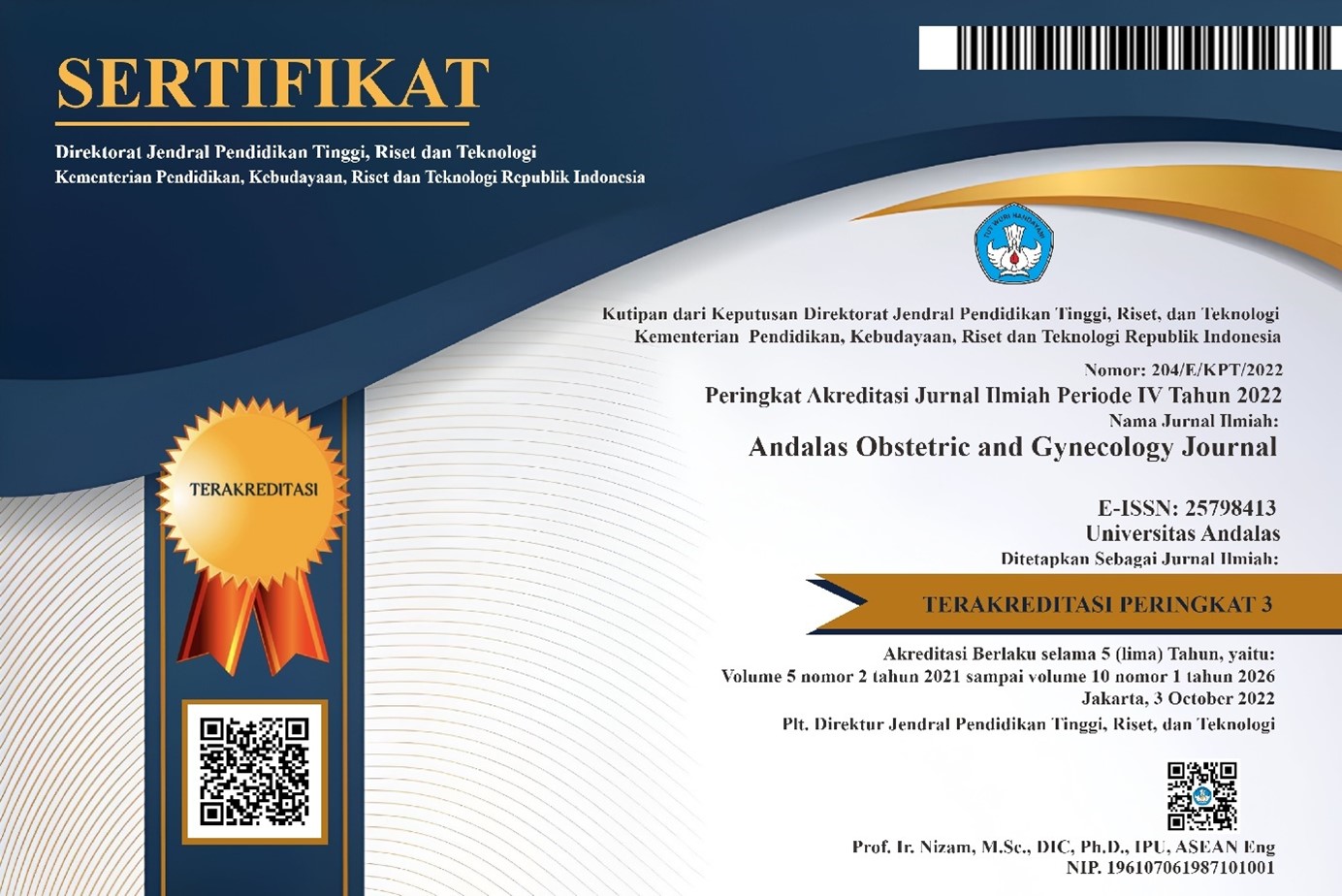Relationship between Behavior, Occupation and Abuse of Psychotropic Drugs and Addictive Substances with Cases of Sexual Violence by Partners Against Women Recorded at the Women Crisis Center in Padang City
DOI:
https://doi.org/10.25077/aoj.7.1.225-233.2023Keywords:
behavior, drugs, job stability, sexual violenceAbstract
Background : One of the main issues affecting reproductive health is sexual violence. Sexual
violence is the third most common form of violence against women (30%) of all cases. Based
on data from the Woman Crisis Center (WCC) in Padang, cases of sexual violence have
continued to increase. There are four main determinants of sexual violence including the
social environment, community, individual and relationship.
Methods: A case-control study is designed to help determine if an determinants is associated
with an outcome. This study was conducted on 66 samples, 33 of whom were female victims
of sexual violence by partners registered at the WCC. The B-SAFER questionnaire is used as
an instrument to assess descriptions of sexual violence committed and psychosocial
assessment of the factors underlying the occurrence of sexual violence. Chi-Square test and
logistic regression are used to analyze the relationship between variables.
Results: There is no significant relationship between the abuse of psychotropic drugs and the
incidence of sexual violence. However, there is a significant relationship between a history of
negative behavior (p = 0.0001) and disruption of job stability (p = 0.0002) to incidents of
sexual violence. Between this two, negative behavior is the factor that most contributes to the
incidence of sexual violence against women, but it is not statistically significant.
Conclusion: Behavior is the most important factor in the occurrence of sexual violence, but
statistically it is not significant. There is no variable that determines sexual violence because
the concept of sexual violence is a complex and polymorphic phenomenon. Further studies
are needed in determining the role of other factors that play a role.
References
Prihatin RB, Martiany D, Mulyadi M, Susiana S. Penghapusan kekerasan seksual
dalam berbagai perspektif. Pusat Penelitian Badan Keahlian DPR RI; 2017.
Wahid A, Irfan M, Hasan MT. Perlindungan terhadap korban kekerasan seksual:
advokasi atas hak asasi perempuan. Refika Aditama; 2001.
Perempuan K. Perempuan dalam himpitan pandemi: Lonjakan kekerasan seksual,
kekerasan siber, perkawinan anak, dan keterbatasan penanganan ditengah covid-19.
Catatan Tah. 2021;
Woman Crisis Centre Nurani Perempuan. Laporan Tahunan Kekerasan terhadap anak
dan perempuan. Padang: WCC Nurani; 2021.
Centers for Disease Control and Prevention (CDC). Violence Prevention at CDC
[Internet]. CDC. 2021.
Greathouse SM, Saunders JM, Matthews M, Keller KM, Miller LL. A review of the
literature on sexual assault perpetrator characteristics and behaviors. Rand Corporation
Santa Monica, CA, USA; 2015.
World Health Organization. Understanding and addressing violence against women:
Intimate partner violence. WHO. 2012.
James J, Proulx J. Theories that explain sexual aggression against women. Wiley
Handb what Work with Sex offenders Contemp Perspect theory, assessment, Treat
Prev. 2020;1–22.
Capaldi D, Knoble N, Shortt J, Kim H. A Systematic review of risks factor for intimate
partner violence. Natl Inst Heal. 2012;3:231–80.
Tharp AT, DeGue S, Valle LA, Brookmeyer KA, Massetti GM, Matjasko JL. A
systematic qualitative review of risk and protective factors for sexual violence
perpetration. Trauma, Violence, Abus. 2013;14:133–67.
Mannell J, Lowe H, Brown L, Mukerji R, Devakumar D, Gram L, et al. Risk factors
for violence against women in high-prevalence settings: a mixed-methods systematic
review and meta-synthesis. BMJ Glob Heal. 2022;7:e007704.
De Wit H. Impulsivity as a determinant and consequence of drug use: a review of
underlying processes. Addict Biol. 2009;14:22–31.
Goldstein RZ, Volkow ND. Dysfunction of the prefrontal cortex in addiction:
neuroimaging findings and clinical implications. Nat Rev Neurosci. 2011;12:652–69.
Downloads
Published
Issue
Section
License
Copyright (c) 2023 Muhammad Zaldy Rasyid Putra, Aladin Aladin, Firdawati Firdawati

This work is licensed under a Creative Commons Attribution 4.0 International License.
Copyright
Authors who publish with this journal agree to the following terms:
- Authors retain the copyright of published articles and grant the journal right of first publication with the work simultaneously licensed under a Creative Commons Attribution 4.0 International License that allows others to share the work with an acknowledgment of the work's authorship and initial publication in this journal.
- Authors are able to enter into separate, additional contractual arrangements for the non-exclusive distribution of the journal's published version of the work (e.g., post it to an institutional repository or publish it in a book), with an acknowledgment of its initial publication in this journal.
- Authors are permitted and encouraged to post their work online (e.g., in institutional repositories or on their website) prior to and during the submission process, as it can lead to productive exchanges, as well as earlier and greater citation of published work (See The Effect of Open Access).
License:
Andalas Obstetrics and Gynecology Journal (AOJ) is published under the terms of the Creative Commons Attribution 4.0 International License. This license permits anyone to copy and redistribute this material in any form or format, compose, modify, and make derivatives of this material for any purpose, including commercial purposes, as long as they credit the author for the original work.







